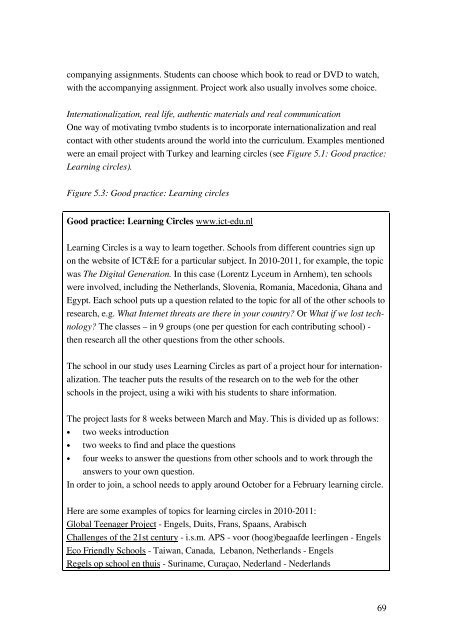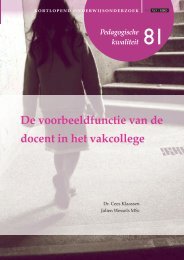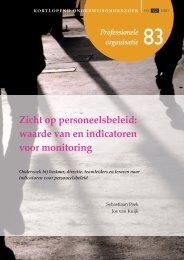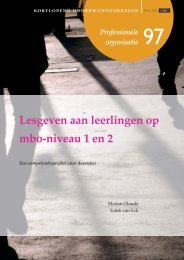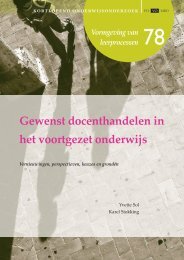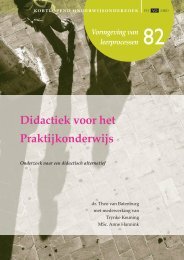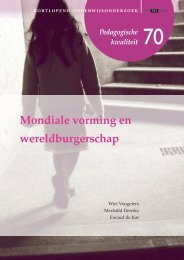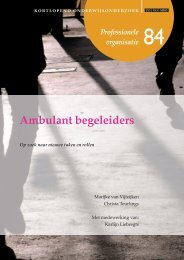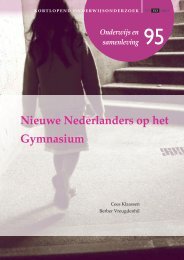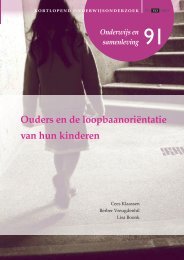Proud to be tvmbo - Kortlopend Onderwijsonderzoek
Proud to be tvmbo - Kortlopend Onderwijsonderzoek
Proud to be tvmbo - Kortlopend Onderwijsonderzoek
You also want an ePaper? Increase the reach of your titles
YUMPU automatically turns print PDFs into web optimized ePapers that Google loves.
companying assignments. Students can choose which book <strong>to</strong> read or DVD <strong>to</strong> watch,<br />
with the accompanying assignment. Project work also usually involves some choice.<br />
Internationalization, real life, authentic materials and real communication<br />
One way of motivating <strong>tvmbo</strong> students is <strong>to</strong> incorporate internationalization and real<br />
contact with other students around the world in<strong>to</strong> the curriculum. Examples mentioned<br />
were an email project with Turkey and learning circles (see Figure 5.1: Good practice:<br />
Learning circles).<br />
Figure 5.3: Good practice: Learning circles<br />
Good practice: Learning Circles www.ict-edu.nl<br />
Learning Circles is a way <strong>to</strong> learn <strong>to</strong>gether. Schools from different countries sign up<br />
on the website of ICT&E for a particular subject. In 2010-2011, for example, the <strong>to</strong>pic<br />
was The Digital Generation. In this case (Lorentz Lyceum in Arnhem), ten schools<br />
were involved, including the Netherlands, Slovenia, Romania, Macedonia, Ghana and<br />
Egypt. Each school puts up a question related <strong>to</strong> the <strong>to</strong>pic for all of the other schools <strong>to</strong><br />
research, e.g. What Internet threats are there in your country? Or What if we lost technology?<br />
The classes – in 9 groups (one per question for each contributing school) -<br />
then research all the other questions from the other schools.<br />
The school in our study uses Learning Circles as part of a project hour for internationalization.<br />
The teacher puts the results of the research on <strong>to</strong> the web for the other<br />
schools in the project, using a wiki with his students <strong>to</strong> share information.<br />
The project lasts for 8 weeks <strong>be</strong>tween March and May. This is divided up as follows:<br />
• two weeks introduction<br />
• two weeks <strong>to</strong> find and place the questions<br />
• four weeks <strong>to</strong> answer the questions from other schools and <strong>to</strong> work through the<br />
answers <strong>to</strong> your own question.<br />
In order <strong>to</strong> join, a school needs <strong>to</strong> apply around Oc<strong>to</strong><strong>be</strong>r for a February learning circle.<br />
Here are some examples of <strong>to</strong>pics for learning circles in 2010-2011:<br />
Global Teenager Project - Engels, Duits, Frans, Spaans, Arabisch<br />
Challenges of the 21st century - i.s.m. APS - voor (hoog)<strong>be</strong>gaafde leerlingen - Engels<br />
Eco Friendly Schools - Taiwan, Canada, Lebanon, Netherlands - Engels<br />
Regels op school en thuis - Suriname, Curaçao, Nederland - Nederlands<br />
69


